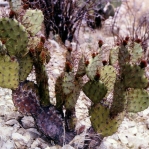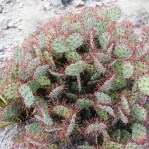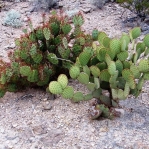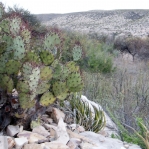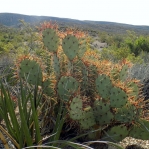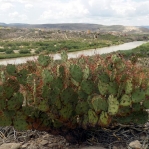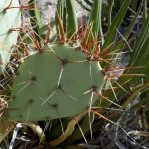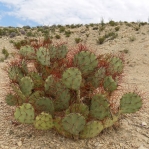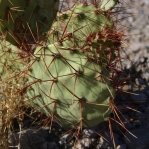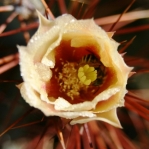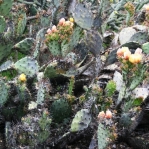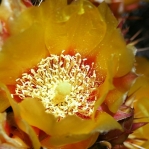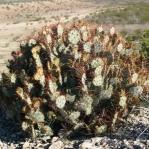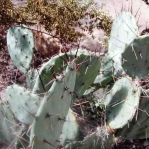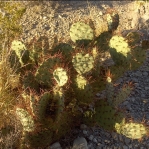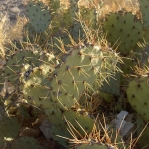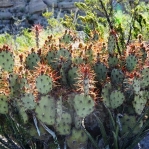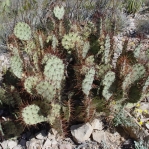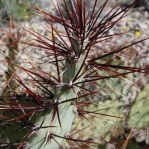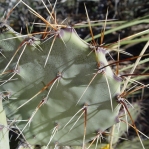
Anthony, American Midland Naturalist 55: 246. 1956
Isotype; Herbarium; Herbarium; Herbarium; Herbarium; Herbarium; Herbarium
Original Description
What is Opuntia spinosibacca?
Opuntia spinosibacca is prickly pear cactus found only in the Big Bend region of Texas and in adjacent Mexico. It is often found on hot limestone substrates. It is a large cactus, to 4-ft tall and 5-ft wide, sometimes with a very short trunk (5 to 8 cm tall) that may be 10-15 cm in diameter.
Details
The cladodes are generally obovate and 10 to 18 cm long and 8 to 15 cm wide. There are 2 to 5 spines in almost all areoles. Mature spines are reddish-orange or even chestnut red; the longest spines are 5 to 10 cm long. Spines age to gray.
From Powell and Weedin:
The plants of O. spinosibacca are upright, compact shrubs to 1- to 1.5-m tall…The pads are light green to yellowish-green [but sometimes appearing bluish] with spines in areoles across most of the pad except near the base. A purple blotch near each areole is often present. Sometimes, a low spreading variant of O. spinosibacca may be confused with a tall plant of O. camanchica.
The cladodes are light green with reddish-brown spines in most areoles, which are elevated and conspicuous. The pads may be relatively small for such a large shrub. Four to eight spines, 2-4 cm long, are present in upper areoles.
Flowers are bright and orange-yellow or golden-yellow, 5 to 7.5 cm wide and 5 to 7 cm long. The bases of the inner tepals are often red or orange. The red coloring may fade to pale pink with age. The filaments are pale green or cream. The style is white or pinkish and up to 2.2 cm long. The stigma is pale green to cream. The pericarpel has glochids and bristles with spines near the apex.
O. spinosibacca is tetraploid.
Other Notes
The taxon is proposed by some botanists to be an Opuntia species created through the natural hybridization of O. aureispina (a diploid species) and O. phaeacantha (a hexaploid species). Hybridization attributed to O. phaeacantha might actually mean O. dulcis, O. camanchica, or some other not-too-large Opuntia. Irrespective of its ancient origins, the taxon is self-reproducing and is considered a discrete species of prickly pear herein.
This prickly pear is a superb plant in larger gardens because of its unique and attractive coloration and its stout look. Mature plants are best in larger gardens.

